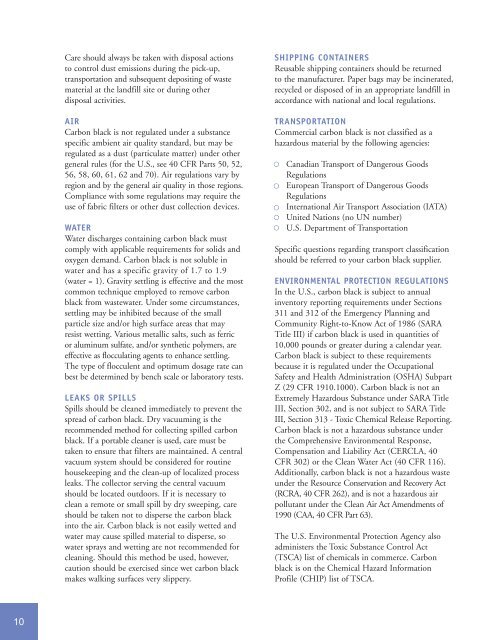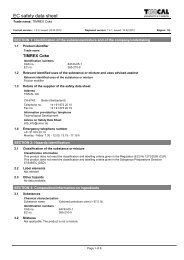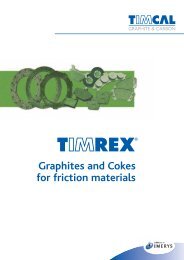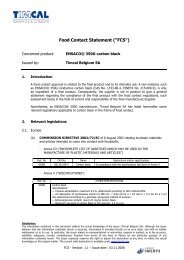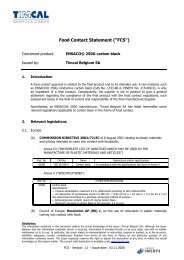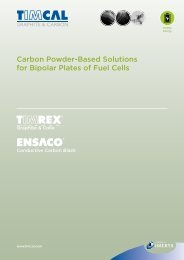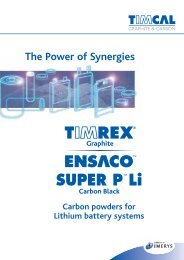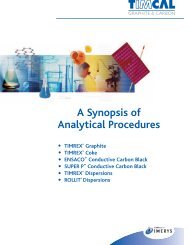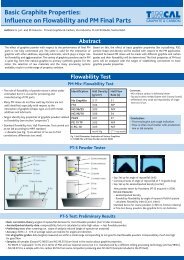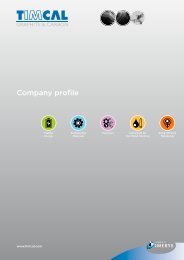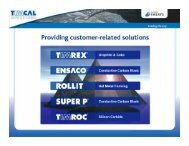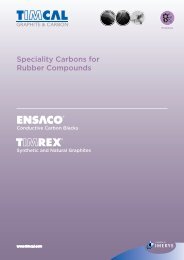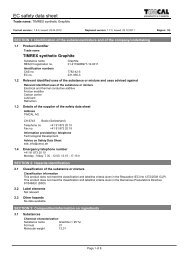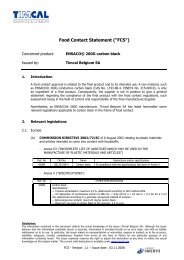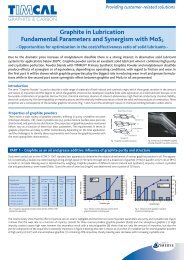Carbon Black Users Guide - Timcal
Carbon Black Users Guide - Timcal
Carbon Black Users Guide - Timcal
You also want an ePaper? Increase the reach of your titles
YUMPU automatically turns print PDFs into web optimized ePapers that Google loves.
Care should always be taken with disposal actionsto control dust emissions during the pick-up,transportation and subsequent depositing of wastematerial at the landfill site or during otherdisposal activities.AIR<strong>Carbon</strong> black is not regulated under a substancespecific ambient air quality standard, but may beregulated as a dust (particulate matter) under othergeneral rules (for the U.S., see 40 CFR Parts 50, 52,56, 58, 60, 61, 62 and 70). Air regulations vary byregion and by the general air quality in those regions.Compliance with some regulations may require theuse of fabric filters or other dust collection devices.WATERWater discharges containing carbon black mustcomply with applicable requirements for solids andoxygen demand. <strong>Carbon</strong> black is not soluble inwater and has a specific gravity of 1.7 to 1.9(water = 1). Gravity settling is effective and the mostcommon technique employed to remove carbonblack from wastewater. Under some circumstances,settling may be inhibited because of the smallparticle size and/or high surface areas that mayresist wetting. Various metallic salts, such as ferricor aluminum sulfate, and/or synthetic polymers, areeffective as flocculating agents to enhance settling.The type of flocculent and optimum dosage rate canbest be determined by bench scale or laboratory tests.LEAKS OR SPILLSSpills should be cleaned immediately to prevent thespread of carbon black. Dry vacuuming is therecommended method for collecting spilled carbonblack. If a portable cleaner is used, care must betaken to ensure that filters are maintained. A centralvacuum system should be considered for routinehousekeeping and the clean-up of localized processleaks. The collector serving the central vacuumshould be located outdoors. If it is necessary toclean a remote or small spill by dry sweeping, careshould be taken not to disperse the carbon blackinto the air. <strong>Carbon</strong> black is not easily wetted andwater may cause spilled material to disperse, sowater sprays and wetting are not recommended forcleaning. Should this method be used, however,caution should be exercised since wet carbon blackmakes walking surfaces very slippery.SHIPPING CONTAINERSReusable shipping containers should be returnedto the manufacturer. Paper bags may be incinerated,recycled or disposed of in an appropriate landfill inaccordance with national and local regulations.TRANSPORTATIONCommercial carbon black is not classified as ahazardous material by the following agencies:Canadian Transport of Dangerous GoodsRegulationsEuropean Transport of Dangerous GoodsRegulationsInternational Air Transport Association (IATA)United Nations (no UN number)U.S. Department of TransportationSpecific questions regarding transport classificationshould be referred to your carbon black supplier.ENVIRONMENTAL PROTECTION REGULATIONSIn the U.S., carbon black is subject to annualinventory reporting requirements under Sections311 and 312 of the Emergency Planning andCommunity Right-to-Know Act of 1986 (SARATitle III) if carbon black is used in quantities of10,000 pounds or greater during a calendar year.<strong>Carbon</strong> black is subject to these requirementsbecause it is regulated under the OccupationalSafety and Health Administration (OSHA) SubpartZ (29 CFR 1910.1000). <strong>Carbon</strong> black is not anExtremely Hazardous Substance under SARA TitleIII, Section 302, and is not subject to SARA TitleIII, Section 313 - Toxic Chemical Release Reporting.<strong>Carbon</strong> black is not a hazardous substance underthe Comprehensive Environmental Response,Compensation and Liability Act (CERCLA, 40CFR 302) or the Clean Water Act (40 CFR 116).Additionally, carbon black is not a hazardous wasteunder the Resource Conservation and Recovery Act(RCRA, 40 CFR 262), and is not a hazardous airpollutant under the Clean Air Act Amendments of1990 (CAA, 40 CFR Part 63).The U.S. Environmental Protection Agency alsoadministers the Toxic Substance Control Act(TSCA) list of chemicals in commerce. <strong>Carbon</strong>black is on the Chemical Hazard InformationProfile (CHIP) list of TSCA.10


